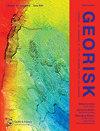魁北克西部地震带的区域地震损失估计和临界地震情景
IF 4.8
3区 工程技术
Q1 ENGINEERING, GEOLOGICAL
Georisk-Assessment and Management of Risk for Engineered Systems and Geohazards
Pub Date : 2023-04-17
DOI:10.1080/17499518.2023.2201246
引用次数: 2
摘要
本文章由计算机程序翻译,如有差异,请以英文原文为准。
Regional seismic loss estimation and critical earthquake scenarios for the Western Quebec seismic zone
ABSTRACT Earthquakes pose potentially substantial risks to residents in the Western Quebec seismic zone of eastern Canada, where Ottawa and Montreal are located. In eastern Canada, the majority of houses are not constructed to modern seismic standards and most homeowners do not purchase earthquake insurance for their homes. If a devastating earthquake strikes, homeowners would be left unprotected financially. To quantify financial risks to homeowners in the Western Quebec seismic zone, regional earthquake catastrophe models are developed by incorporating up-to-date public information on hazard, exposure and vulnerability. The developed catastrophe models can quantify the expected and upper-tail financial seismic risks by considering a comprehensive list of possible seismic events as well as critical earthquake scenarios based on the latest geological data in the region. The results indicate that regional seismic losses could reach several tens of billions of dollars if a moderate-to-large earthquake occurs near urban centres in the region, such as Montreal and Ottawa. The regional seismic loss estimates produced in this study are useful for informing earthquake risk management strategies, including earthquake insurance and disaster relief policies.
求助全文
通过发布文献求助,成功后即可免费获取论文全文。
去求助
来源期刊
CiteScore
8.70
自引率
10.40%
发文量
31
期刊介绍:
Georisk covers many diversified but interlinked areas of active research and practice, such as geohazards (earthquakes, landslides, avalanches, rockfalls, tsunamis, etc.), safety of engineered systems (dams, buildings, offshore structures, lifelines, etc.), environmental risk, seismic risk, reliability-based design and code calibration, geostatistics, decision analyses, structural reliability, maintenance and life cycle performance, risk and vulnerability, hazard mapping, loss assessment (economic, social, environmental, etc.), GIS databases, remote sensing, and many other related disciplines. The underlying theme is that uncertainties associated with geomaterials (soils, rocks), geologic processes, and possible subsequent treatments, are usually large and complex and these uncertainties play an indispensable role in the risk assessment and management of engineered and natural systems. Significant theoretical and practical challenges remain on quantifying these uncertainties and developing defensible risk management methodologies that are acceptable to decision makers and stakeholders. Many opportunities to leverage on the rapid advancement in Bayesian analysis, machine learning, artificial intelligence, and other data-driven methods also exist, which can greatly enhance our decision-making abilities. The basic goal of this international peer-reviewed journal is to provide a multi-disciplinary scientific forum for cross fertilization of ideas between interested parties working on various aspects of georisk to advance the state-of-the-art and the state-of-the-practice.

 求助内容:
求助内容: 应助结果提醒方式:
应助结果提醒方式:


